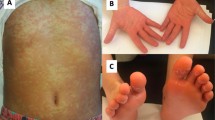Abstract
Chelation therapy is often used to treat mercury poisoning. Public health personnel are often asked about mercury toxicity and its treatment. This paper provides a public health department response to use of a mercury-containing cosmetic in Minnesota, a perspective on two unpublished cases of chelation treatment for postulated mercury toxicity, and comments on the use of a nonsystemic treatment for removal of mercury following the Iraqi seed coat poisoning incident. Physicians should evaluate sources of exposure, biomarkers, and risks and benefits before recommending chelation therapy for their patients. Potential risks to chelation therapy and its little understood subtle or latent effects are areas of public health concern.
Similar content being viewed by others
References
Fish Consumption Advise. Minnesota Department of Health. Available at: http://www.health.state.mn.us/divs/eh/fish/index.html. Accessed August 2013
Choi-Lao ATH, Corte G, Dowd G, Lao RC (1979) Mercury vapor as a contaminant of hospital environment. Sci Total Environ 11(3):287–292
Task Force on Ritualistic Uses of Mercury Report. Office of Emergency and Remedial Response; United States Environmental Protection Agency. December 2002. Available at: http://www.epa.gov/superfund/community/pdfs/mercury.pdf. Accessed August 2013
Warkany J. Acrodynia—Postmortem of a Disease. Am J Dis Child 1966;112(2):146–156. Available at: http://archpedi.jamanetwork.com/article.aspx?articleid=501896. Accessed August 2013
Mercury exposure from interior latex paint – Michigan. MMWR 1990;39(8):125–126. Available at: http://www.cdc.gov/mmwr/preview/mmwrhtml/00001566.htm. Accessed August 2013
Minnesota Department of Health and the MN Regional Poison Center. Mercury exposure from Skin-Lightening Products Fact Sheet for Health Care Providers. 2011. Available at: http://www.health.state.mn.us/topics/skin/provfs.pdf and http://www.health.state.mn.us/topics/skin/ Accessed August 2013
Copan L, Ujihara A, Jones C, Das R, Kreutzer R et al (2012) Mercury exposure among household users and nonusers of skin-lightening creams produced in Mexico—California and Virginia, 2010. MMWR 61:33–36
Harada M (1995) Minamata disease: methyhlmercury poisoning in Japan caused by environmental pollution. Crit Rev Toxicol 25(1):1–24
Skerfving SB, Copplestone JF. Poisoning caused by the consumption of organomercury-dressed seed in Iraq. Bull World Health Organ 1976;54:101–112. Available at: http://www.ncbi.nlm.nih.gov/pmc/articles/PMC2366450/pdf/bullwho00452-0108.pdf. Accessed August 2013
von Mühlendahl K (1990) Intoxication from mercury spilled on carpets. Lancet 336(8730):1578
Velzeboer S, Frenkel J, de Wolff F (1997) A hypertensive toddler. Lancet 349(9068):1810
Chrysochoou C, Rutishauser C, Rauber-Luthy C, Neuhaus T, Boltshauser E, Superti-Furga A (2003) An 11-month-old boy with psychomotor regression and auto-aggressive behaviour. Eur J Pediatr 162:559–561
Clarkson TW, Magos L, Cox C, Greenwood MR, Amin-Zaki L et al (1981) Tests of efficacy of antidotes for removal of methylmercury in human poisoning during the Iraq outbreak. J Pharmacol Exp Ther 218(1):74–83
Norseth T, Clarkson TW (1970) Studies on the biotransformation of 203Hg-labeled methyl mercury chloride in rats. Arch Environ Health 21(6):717–727
US Environmental Protection Agency (2001) Water quality criterion for the protection of human health: methylmercury Chapter 4: risk assessment for methylmercury. Office of Science and Technology, Office of Water, Washington, D.C, EPA-823-R-01-001, January 2001
Acknowledgment
This publication was supported by the cooperative agreement award number 1U61TS000117-04 from the Agency for Toxic Substances and Disease Registry (ATSDR). Its contents are the responsibility of the authors and do not necessarily represent the official views of the Agency for Toxic Substances and Disease Registry (ATSDR).
Conflict of Interest
For the work under consideration for publication, Dr. McKay received a consulting fee/honorarium and reimbursement for travel through the ACMT/ATSDR Cooperative Agreement. Relevant financial activities outside the submitted work included money paid by the state DPH and various private attorney’s firms to Dr. McKay and to Dr. McKay’s institution for consulting on cases involving chelation issues. Dr. McKay is on the Scientific Advisory Council for the Environmental Health Research Foundation, which addresses issues related to biomonitoring for environmental chemicals. Dr. Herbrandson received reimbursement for travel to the conference through the ACMT/ATSDR Cooperative Agreement.
Author information
Authors and Affiliations
Corresponding author
Rights and permissions
About this article
Cite this article
McKay, C.A. Public Health Department Response to Mercury Poisoning: The Importance of Biomarkers and Risks and Benefits Analysis for Chelation Therapy. J. Med. Toxicol. 9, 308–312 (2013). https://doi.org/10.1007/s13181-013-0340-9
Published:
Issue Date:
DOI: https://doi.org/10.1007/s13181-013-0340-9




